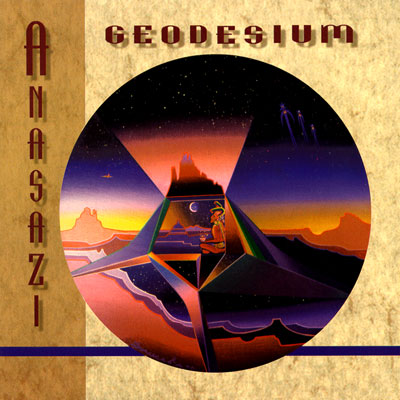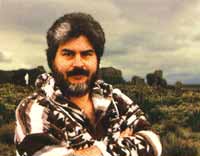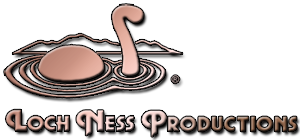

Anasazi
Space Music... From the Dawn of the Second Millennium
The futuristic planetarium space music of Mark C. Petersen often takes its inspiration from humanity's space-faring future among the stars and planets. In his newest release, Petersen's music has taken a different cue — from the past — in "Anasazi", the fifth album of the Geodesium series.
A composer and producer of planetarium music since 1975, Petersen uses the name Geodesium for his one-man recordings. His last two albums — "West Of The Galaxy" and "Fourth Universe" — have had a decidedly outer-space flavor, and have received national attention on such radio programs as "Music From The Hearts Of Space", "Musical Starstreams", and "Echoes".
Released in December 1993, Geodesium Anasazi contains a pair of suites that create aural impressions of two cultures existing in the Western Hemisphere long before Europeans made their first advances to the New World — the Anasazi and the Aztec.
"The Anasazi first made their homes in the Chaco Canyon area of New Mexico and Colorado more than a thousand years ago," Mark said. "But, they disappeared or moved on in the 1100s. It's always been sort of a mystery about where they went. But, they left behind cities and artifacts that tell us a great deal about their way of life."
Farther south and more than four hundred years after the Anasazi departed, the flourishing warrior culture of the Aztec encountered the Spanish conquistadors. "These people were ritually and spiritually bound together as warriors — as people of the Sun. They didn't disappear, but their ancient cities and temples fell to the soldiers of Spain and Christianity," said Mark.
So, why perform music that reminds listeners of these cultures? In both cases, Mark was commissioned to create soundtracks for two planetarium shows: one that studied the decline of the Anasazi as a result of changes in their environment, and another that presented the astronomical practices of the Aztec warrior-priests. He wasn't interested in specifically recreating the music of the two cultures, but — looking ahead to creating this album — he decided to make "impressionistic" music instead.
Mark uses electronic keyboards and synthesizers to create the instrumental music, but the sounds coming from behind the keys are often digital recordings of actual instruments. The Anasazi suite features sampled sounds of flutes, drums and voices, and the Aztec suite intermingles guitars and pan flutes with wind chimes, percussion and voices to evoke mental pictures of the People of the Sun. The use of modern instruments to perform music reminiscent of the past provided a challenge.
"I've amassed quite a library of what you might call quintessential space sounds and synthesizer patches, from doing planetarium show soundtracks over the past 18 years. And most of it, I couldn't use to make this album," Mark commented.
While obviously electronic-sounding instruments work well for conveying pictures of outer space, Mark found his subject material to be very terrestrial, very Earth-based. "I needed to create more primitive-sounding music, something more organic, more human-feeling," he said. "Yet, I'm not trying to recreate the life and times of these people. I'm attempting to create futuristic space music to convey the flavor of time a thousand years old — with the instruments of today. It's all quite paradoxical."
Since much of the music was composed to set scenes and moods in a planetarium program, the musical content was sometimes dictated by the show's script. For example, Mark created a work called Water Prayer, which depicts a Chacoan youth kneeling beside a trickling stream, giving thanks for its precious gift of life. "The availability of water played a critical role in the Anasazi's survival," he said. "In the planetarium soundtrack, there was documentary narration about how the Anasazi used and conserved water, which is mixed on top of the music. But, when the piece is featured by itself as foreground rather than background music, it can take on a life of its own, and paint pictures greater than the original context of that dictated by the show."
"In Water Prayer, while my mental image was of a Native flute player by a stream, the actual flute sound I used is from a Japanese shakuhachi, and the accompaniment is arpeggios from a kalimba, which has African roots. In People Of The Sun, I mixed a classical guitar ostinato with a xylophone melody and a conga drum rhythm. In the context of how they're heard, the origin of the instruments is really irrelevant — especially when they're used in non-traditional ways, or combined with synthesizer elements. I'm creating new-but-still-familiar tonal palettes to paint the pictures, utilizing some pretty exotic instruments, too."
The music on Anasazi should appeal to those who enjoy 'world music', or even 'Native' music, although Petersen noted he's not trying to be historically accurate in reproducing any specific music of a period or indigenous culture. "This is just my take on creating music which speaks to me of the time," he said. "It might say something else to other listeners."
There's also a chronological development of theme portrayed throughout the Anasazi suite. The opening flute motif first echoes through Call Of The Canyon, and is treated in a raw primitive form in the title cut Anasazi. The music becomes more complex, detailed, and modernistic with each successive piece. The final cut, Sun Dogs, may seem out of context on first listening; a jazz-fusion quartet jams frenetically, with a flautist taking the original theme into a modern chordal structure. "There's a lot for the listener to 'read into' the music," said Mark. "Are echoes of the past finding a place in the music of today? Does it speak as a yearning of modern culture for a return to a simpler time, to the values of the past? Is such a meld of old and new valid and meaningful?"
Mark thinks that, in the end, these are questions we can only answer for ourselves. "I've created music that I feel is valid and enjoyable, no matter in what context it's heard, or with whatever aura of cultural preconceptions one wishes to place it in," he said.
The 17 selections on the hour-long album showcase a wide variety of styles, from dramatic, echoing tone poems like Chetro Ketl and The Warrior Awaits to the orchestral soundscapes Chaco Twilight and The Great Temple; mystical, floating works such as Tianquiztli and Wijiji, and more contemporary, New Age-type songs Cycles of Night, Shadows on Sandstone, and Stars Over The Pyramid. The cover art features a spiritual painting by Colorado Yaqui artist Mario Sauceda.
Throughout his career as a composer and as a planetarian, Mark has worked to define the genre of "planetarium space music". His music enhances planetarium programs and science center presentations around the world. Chances are, if you've been to a planetarium recently, you've heard Mark's music. More than 690 planetarium facilities in the U. S. and 50 other countries have purchased music or shows from Mark's company, Loch Ness Productions.
"Anasazi isn't a complete departure in style from the other planetarium space music albums in the Geodesium series. It's more of an expansion, an embellishment of the Geodesium sound, a familiar style in a new context," Mark mused "There's plenty for the Geodesium fan to recognize and enjoy in this new album. And I hope that those whose first experience with Geodesium comes from hearing this album will be encouraged to check out the other albums. The instrumental style and elements of sound and melody I've been creating should be recognizable throughout them all."


